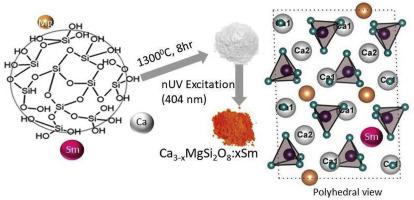Solid State Sciences ( IF 3.4 ) Pub Date : 2021-05-19 , DOI: 10.1016/j.solidstatesciences.2021.106647 R.K. Padhi , P. Vinodkumar , Sitakanta Panda , B.S. Panigrahi

|
Photoluminescence properties of a series of Sm+3 doped ternary alkaline earth silicate phosphor: Ca3−xMgSi2O8:xSm+3, synthesized by sol-gel method, were investigated. The crystal structure of the prepared phosphors was characterized by X-ray diffraction (XRD), scanning electron microscopy (SEM), and Fourier transforms infrared (FTIR) spectroscopy. The phosphor crystallized into a monoclinic crystal system in P121/a1 space group as a pure single-phase nano-powder. Rietveld refinement results elucidate the presence two coordination sites for Ca2+ ions in the lattice and both can be replaced with Sm3+ upon doping. Among the several excitation peaks observed in the UV region, 6H5/2 → 4F7/2 (404 nm) transition was most prominent. The emission profile was comprised of four bands centring at 563, 600, 647, and 707 nm and among them 4G5/2 6H7/2 (600 nm) was the dominant transition. Luminescence quenching appeared beyond the optimum doping concentration of 2 mol %. The exchange mechanism responsible for the concentration quenching was primarily associated with quadrupole-quadrupole interactions. The luminescence demonstrated mono-exponential decay below 0.25 mol% and bi-exponential decay above 0.5 mol% Sm3+ concentration. The observed bi-exponential decay could be attributed to the samarium luminescence from two different coordination sites. The presence of the isoemissive point in the time resolved area normalised emission spectra (TRANES) confirmed the existence of two distinct luminescent centres in the samarium doped Ca3MgSi2O8. Analysis of decay amplitudes validated the TRANES observation and ascribed the origin of fast and slow components of the bi-exponential decay to emission from Sm3+ ions occupied at two distinct Ca sites. The luminescence lifetime ( = 2.13 ms), quantum yield (57.36%) and chromaticity parameters indicated that Ca3−xMgSi2O8:xSm+3 can be a promising phosphor for the red spectral component in nUV- wLED application.
中文翻译:

利用时间分辨发射光谱法分析密集堆积的Ca 3 MgSi 2 O 8纳米晶体中Sm 3+的位占据和光致发光特性
研究了通过溶胶-凝胶法合成的一系列Sm +3掺杂的三元碱土金属硅酸盐荧光粉:Ca 3− x MgSi 2 O 8:xSm +3的发光特性。制备的磷光体的晶体结构通过X射线衍射(XRD),扫描电子显微镜(SEM)和傅立叶变换红外光谱(FTIR)进行表征。磷光体以纯单相纳米粉的形式结晶为P121 / a1空间群的单斜晶系。Rietveld精炼结果阐明了晶格中Ca 2+离子存在两个配位点,并且都可以被Sm 3+取代掺杂后。在紫外线区域观察到的几个激发峰中,6 H 5/2 → 4 F 7/2(404 nm)跃迁最为突出。发射曲线由四个分别位于563、600、647和707 nm的波段组成,其中4 G 5/2 6 H 7/2(600 nm)是主要转变。出现了发光猝灭,超过了最佳掺杂浓度2 mol%。引起浓度猝灭的交换机理主要与四极-四极相互作用有关。发光显示出Sm 3+浓度低于0.25mol%的单指数衰减和高于0.5mol%的双指数衰减。观察到的双指数衰减可能归因于来自两个不同配位点的sa发光。时间分辨区域归一化发射光谱(TRANES)中等渗点的存在证实了do掺杂的Ca 3 MgSi 2 O 8中存在两个不同的发光中心。衰减幅度的分析验证了TRANES的观测结果,并将双指数衰减的快速和慢速分量的起源归因于占据两个不同Ca位置的Sm 3+离子的发射。发光寿命 = 2.13 ms),量子产率(57.36%)和色度参数表明Ca 3- x MgSi 2 O 8:xSm +3可以成为nUV-wLED应用中红色光谱成分的有前途的荧光粉。











































 京公网安备 11010802027423号
京公网安备 11010802027423号